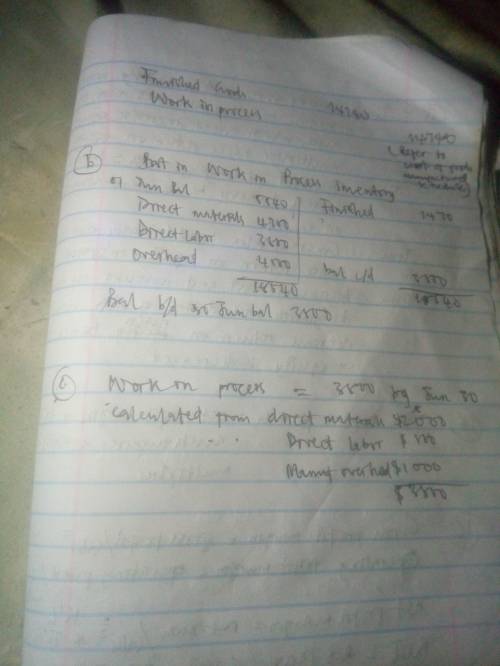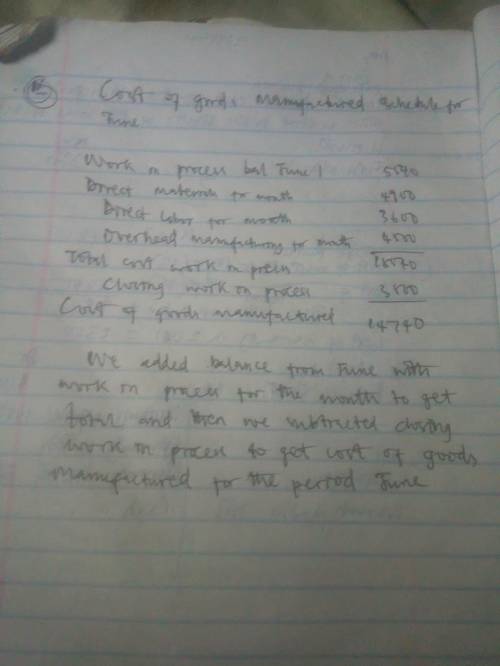
Business, 17.10.2020 20:01 twistedgamerhd12
Case Inc. is a construction company specializing in custom patios. The patios are constructed of concrete, brick, fiberglass, and lumber, depending upon customer preference. On June 1, 2017, the general ledger for Case Inc. contains the following data.
Raw Materials Inventory $4,200 Manufacturing Overhead Applied $32,640
Work in Process Inventory $5,540 Manufacturing Overhead Incurred $31,650
Subsidiary data for Work in Process Inventory on June 1 are as follows.
Job Cost Sheets
Customer Job
Cost Element Rodgers Stevens Linton
Direct materials $600 $800 $900
Direct labor 320 540 580
Manufacturing overhead 400 675 725
$1,320 $2,015 $2,205
During June, raw materials purchased on account were $4,900, and all wages were paid. Additional overhead costs consisted of depreciation on equipment $900 and miscellaneous costs of $400 incurred on account.
A summary of materials requisition slips and time tickets for June shows the following.
Customer Job Materials Requisition Slips Time Tickets
Rodgers $800 $850
Koss 2,000 800
Stevens 500 360
Linton 1,300 1,200
Rodgers 300 390
4,900 3,600
General use 1,500 1,200
$6,400 $4,800
Overhead was charged to jobs at the same rate of $1.25 per dollar of direct labor cost. The patios for customers Rodgers, Stevens, and Linton were completed during June and sold for a total of $18,900. Each customer paid in full.
Instructions
Journalize the June transactions: (1) for purchase of raw materials, factory labor costs incurred, and manufacturing overhead cost incurred; (2) assignment of direct materials, labor, and overhead to production; and (3) completion of jobs and sale of goods.
Post the entries to Work in Process Inventory.
Reconcile the balance in Work in Process Inventory with the costs of unfinished jobs.
Prepare a cost of goods manufactured schedule for June.

Answers: 3


Another question on Business

Business, 21.06.2019 23:00
Assume today is december 31, 2013. barrington industries expects that its 2014 after-tax operating income [ebit(1 – t)] will be $400 million and its 2014 depreciation expense will be $70 million. barrington's 2014 gross capital expenditures are expected to be $120 million and the change in its net operating working capital for 2014 will be $25 million. the firm's free cash flow is expected to grow at a constant rate of 4.5% annually. assume that its free cash flow occurs at the end of each year. the firm's weighted average cost of capital is 8.6%; the market value of the company's debt is $2.15 billion; and the company has 180 million shares of common stock outstanding. the firm has no preferred stock on its balance sheet and has no plans to use it for future capital budgeting projects. using the corporate valuation model, what should be the company's stock price today (december 31, 2013)? round your answer to the nearest cent. do not round intermediate calculations.
Answers: 1


Business, 23.06.2019 00:00
Wo firms, a and b, each currently dump 50 tons of chemicals into the local river. the government has decided to reduce the pollution and from now on will require a pollution permit for each ton of pollution dumped into the river. it costs firm a $100 for each ton of pollution that it eliminates before it reaches the river, and it costs firm b $50 for each ton of pollution that it eliminates before it reaches the river. the government gives each firm 20 pollution permits. government officials are not sure whether to allow the firms to buy or sell the pollution permits to each other. what is the total cost of reducing pollution if firms are not allowed to buy and sell pollution permits from each other? what is the total cost of reducing pollution if the firms are allowed to buy and sell permits from each other? a. $3,000; $1,500 b. $4,500; $3,500 c. $4,500; $4,000 d. $4,500; $2,500
Answers: 3

Business, 23.06.2019 02:00
Opportunity cost is calculated by which of the following? a. adding the value of all lost opportunities. b. subtracting all costs from the total benefit. c. calculating the cost of time, energy, and sacrifice. d. finding the value of the best option that is not chosen.
Answers: 1
You know the right answer?
Case Inc. is a construction company specializing in custom patios. The patios are constructed of con...
Questions


Mathematics, 02.12.2020 14:00


Mathematics, 02.12.2020 14:00

Advanced Placement (AP), 02.12.2020 14:00




Biology, 02.12.2020 14:00

History, 02.12.2020 14:00

Computers and Technology, 02.12.2020 14:00

Physics, 02.12.2020 14:00



Social Studies, 02.12.2020 14:00



English, 02.12.2020 14:00

Social Studies, 02.12.2020 14:00

Mathematics, 02.12.2020 14:00






